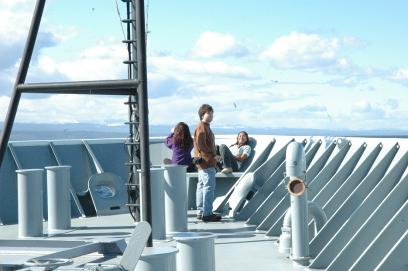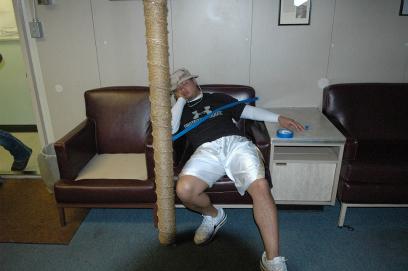
|
Click on the question mark to ask the class about oceanography, Glacier Bay, or the cruise.† Your question and answer will appear on the Questions page under Quick Links. |

|
7:30 AM After weeks of preparation we cast off from downtown Seattle around 8:00 pm last night.† Despite uniform end-of-quarter fatigue, almost everyone was too keyed up to sleep.† Games of Cranium and Scrabble in the library past the time until we could fall asleep.
Sometime early this morning we crossed the 49th parallel and entered Canadian waters.† In a couple of days we will reach Glacier Bay and thereís much to be done between now and then.† Equipment needs to be prepped, protocols written up and reviewed, and watches established (science on the Thompson happens 24 hours a day).† Almost all of the students have final exams to take before science operations commence.
By research vessel standards life aboard the Thompson is pretty good.† The staterooms are spacious (see ďAnatomy of a Stateroom Below), the lab space is very ample (check out the R/V Thomas G Thompson link at left for a complete ship tour), and the food is great.† No one ever loses weight on a Thompson cruise!
-Jeff
|
|
March 15, 2008 |


|
Anatomy of a Stateroom |
|
9:30 AM Last night was our first night aboard the Thompson and I can still remember just about everything that happened every minute up until I woke up.† We started the night with long safety and scientific meetings.† We got lectured for a couple of hours on everything from dawning exposure suits, getting MSDS for biohazard chemicals and not taking a shower with the head door open and setting off the fire alarms.† Then the rest of the night was ours.†
We took some pictures of a beautiful downtown backdrop, played ping-pong, talked about tea and explored the Thompson.† The night capped with a brain busting game of Cranium that ended around midnight when everyone decided to call it quits.† Then for me it beganÖ tossingÖ. turningÖ eyes wide open cause I canít sleep in a 2.5í wide x 2.5í high x 7í long metal box with a poor excuse for a mattress.†
Around 3:00 or 4:00 AM I thought I was in the middle of a mechanical nightmare, but I was still awake.† The forward thrusters cranked on and the sound of a muted thump as my neighbors head hit the top of his bunk.† The sound was so loud Iíd be surprised it didnít wake everyone on the ship.† It was like a combination of NASCAR and Stomp at the Planet Hollywood Hotel and Casino, Las Vegas at 4:00 in the morning.† It lasted for a few minutes and then the gentle rocking of the Thompson made me queasy and finally put me to sleep for a few hours only to wake to the sound most people dread in the morning; the alarm clock to start the next day.
-Erwin
|



|
Plenty of company from ferries and freighters as we parallel the route taken by ships traveling the Alaska Marine Highway.† |

|
Ping pong in the main lab is a time honored, traditional pastime on the Thompson.† Erwin and Marcus battle it out. |

|
Quick!† The sunís out!!.† Carmela, Aubrey, and Brandon enjoy some rays and scenery. |

|
All gear must be secured at all times.† Erwin catches up on lost sleep. |
|
5:30 PM All day we continued cruising toward the Inside Passage, alternating between narrow passes and broad basins.† The weather is beautiful now with clear skies, but the wind is intense!† Even dressed for the cold you canít stand more than a couple minutes out on the bow of the ship.
The scenery and wildlife are impressive; much of this area is protected by the British Columbia Provincial Parks system.† One of the parks we passed by is the ecologically important bird sanctuary at Mitlenach Island (click on the links below for more information).† Seabirds flock to Mitlenatch as a result of its unique location.† Local currents upwell nutrient rich water near the island, increasing biological productivity.† It is this kind of interaction between physical, chemical, and biological processes that we hope to study in more detail within Glacier Bay.
If youíve been following along with the shipís location (see the link to the left) you may be wondering how the Thompson and other ships navigate the complex network of channels and passes between Georgia Basin (just north of Puget Sound) and Glacier Bay.† Even with radar, GPS, and electronic charts intimate local knowledge is required for safe passage.† For this knowledge the ship relies on a contingent of three Canadian pilots, senior skippers with years of experience in the Inside Passage.† It takes over 2000 days of coastal sea time to qualify for the pilotís test, and years more experience for complete certification.† In the narrow passages itís easy to see why.† The largest ships that travel the Passage are nearly 900 feet long, three times the length of the Thompson.† With traffic in both directions and currents that can exceed 12 knots, maneuvering can get very tight.
-Jeff
http://en.wikipedia.org/wiki/Mitlenatch_Island_Nature_Provincial_Park http://www.env.gov.bc.ca/bcparks/explore/parkpgs/mitlenat.html |


|
Instructor Rick Keil, Dan, Eric, and Josh prep line that will be used to deploy sediment traps. |

|
A heavily loaded barge progresses through the Inside Passage ahead of the Thompson. |
|
Quick Links
Senior Thesis Research Course, Ocean 444
Senior Thesis Planning Course, Ocean 443
Quick Links to Blog Entries
|
|
Glacier Bay banner background image by Andy Cameron, see original image. Send mail to: seniorcruise2008@ocean.washington.edu |